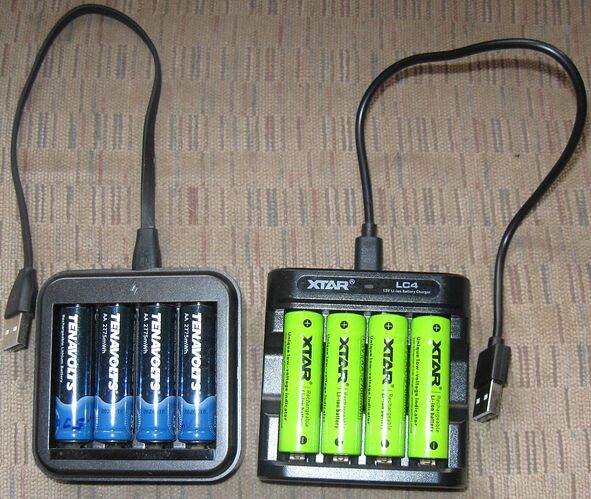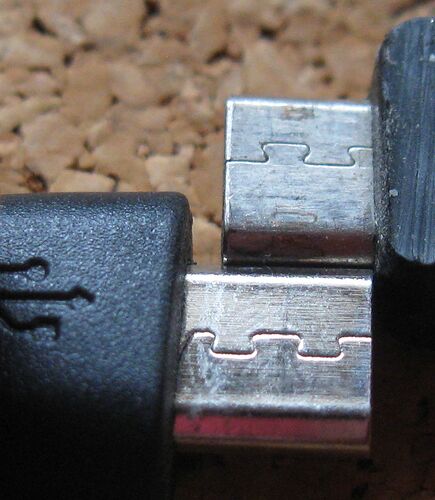This will be a review of the kit introduced late last year consisting of four XTAR 1.5V AA rechargeable cells and matching, dedicated charger. XTAR donated the kit to me at no cost in return for an honest review on BLF. I have no other association with XTAR in any way.
1.5v AA rechargeable cells don’t exhibit the lower voltage (~1.2v nominal) common to NiMh cells. This can be a necessary advantage for devices that whine about low voltage on 1.2v NiMh cells. The 1.5v rechargeables typically maintain full 1.5 volts until abruptly shutting down. The XTAR cells in this review have incorporated into them a function claimed to give a low-battery warning on devices so equipped prior to shutdown.
As part of the review I’ll also be comparing the XTAR AA kit with a similar AA kit under the brand name TENAVOLTS; four TENAVOLTS 1.5V AA rechargeable cells and matching, dedicated charger. They’re two yrs. old this month, purchased by me from Amazon on some flash discount or other short-term savings. I have no association with TENAVOLTS in any way, nor have I been compensated by TENAVOLTS.
Please keep in mind while reading this review that the TENAVOLTS cells are two yrs. old, with maybe three charge / discharge cycles on them prior to this review. TENAVOLTS may well have modified their offerings since then, which might change the comparison outcome.
The test mule is my trusty old Canon PowerShot A590 camera. This is a camera that’s very picky when it comes to AA cells. Even using freshly charged Eneloop, Eneloop Pro or Fujitsu AA NiMh cells, the number of shots available from them is very limited before the camera whines about cell voltage and abruptly shuts down. Cold weather shortens available lifetime of NiMh cells even more, if they work at all. Lithium primary AA’s are far better in both respects, but even they have much lifetime remaining for other, less demanding devices when the camera demands fresh cells. The A590 eats alkies like candy, again leaving lots of capacity left over for use in any device not as demanding.
Counting camera-shots-per-cell-pair is fairly subjective, due to variables such as screen-on time, flash usage (or not), and temperature. Seeing as how I don’t have any kind of advanced testing equipment for cell testing and, wishing to make as scientific a review as possible, I began by testing mAh capacity in my Opus 3100 V2.2, with draw set to 0.30A. The XTAR cells returned mAh capacities ranging from 1,581 to 1,621, about what I expected. The Tenavolt cells all returned ‘NULL’ results every time in four attempts on the OPUS 3100.
Printed on each XTAR cell is the statement “Built-in protection of Over-charge/Over-discharge/short- circuit”, and “Unique low-voltage indicator”, which is a unique feature claimed by XTAR for their rechargeable 1.5V cells.
This is purported to be a function that is intended to trigger a low-battery warning on the device being powered by them, if so equipped. When specifically asked, XTAR indicated that the output of their cells would drop to “around 1.1 V” when the XTAR’s low-voltage feature is engaged. That feature may be an explanation of the different results on the Opus charger. When using the XTAR cells I did in fact see a low-battery warning triggered on the A590, something I never saw with the TENAVOLTS cells. When the low-battery icon appeared, I had maybe 3~5 flash shots left before shutdown, about the same as when using alkies, longer than when using NiMh cells, and much shorter than when lithium primaries are used. I conclude that the low-battery warning of the XTAR cells works as advertised in my Canon A590 camera.
Advantage: XTAR
Due to the failure of the Opus charger to return usable mAh info on the TENAVOLTS cells, I went in search of something more suitable and, in keeping with the 'Budget” focus of our forum, not very expensive. As luck would have it, I stumbled across a review of the ZH-YU ZB206+ v1.3 Battery Capacity Tester / Battery Life / Internal Resistance Analyzer while perusing kerosene hurricane lantern info, of all things. (I’ll be posting a review of the ZB206+ device in the near future). The 206+ returned usable, repeatable data on both mAh and (importantly), mWh capacities of both the XTAR and Tenavolts cells. I used the ZB206+ for all subsequent testing.
Moving on to the comparison:
The XTAR cells are rated at 2,700 mWh. TENAVOLTS cells are rated at 2,775 mWh. No mAh specs are given for either brand.
Claimed rating advantage: TENAVOLTS
I prefer to charge my cells of any chemistry at relatively low currents, and used a USB power supply producing 1.0A of current for the entirety this review. That theoretically splits charging current to .25 mA charging current per cell when using the XTAR and TENAVOLTS chargers.
The chargers are very similar in appearance.
Both came with USB charging cables, the XTAR being USB-C and the TENAVOLTS using USB-micro. Here a design issue becomes apparent; the USB-micro receptacle in the TENAVOLTS charger is deeply inset in the plastic body of the charger. So much so that all other USB-micro cables I tried didn’t have long enough micro plugs to reliably connect. Comparing the TENAVOLTS micro-USB plug to other USB-micro plugs of unknown origin I had in the drawer revealed the micro-USB plug on the TENAVOLTS cable is somewhat longer (.5mm or so) that that of other USB-micro cables (TENAVOLTS plug on the bottom).
Not exactly proprietary, but enough of a difference to make it necessary to keep the TENAVOLTS cable paired to it’s own charger simply for reliability.
Advantage: XTAR
The XTAR charger is, in our opinion, easier to use compared to the TENAVOLTS charger because of the XTAR charger’s ergonomic design. The cutouts in the sides & bottom of the XTAR charger make it much easier to remove the cells by simply hooking a fingertip under the cells & lifting. Fine, subtle human ergonomic engineering. The TENAVOLTS charger on the other hand isn’t as easy to use; the cells must be sort of pried out by hooking a fingernail under the edge of the wrapper at the positive end, then lifting to overcome the spring pressure at the negative end. Wife didn’t like doing so, because it put the warpaint on her claws at risk.
Advantage: XTAR.
The XTAR cells have green LED’s under the positive buttons that rhythmically blink while charging, then become solid green when fully charged. TENAVOLTS cells illuminate solid blue LED’s at the positive buttons while charging, which are extinguished when fully charged. Interestingly, when deeply discharged on the test stand until shutdown, the green charging indicators on the XTAR cells sometimes would not immediately energize at all when charging commenced. I feared I’d damaged the cells somehow by doing deep discharge testing. Once on the charger for a few minutes though, they would begin flashing at random intervals, eventually settling down to their typical, rhythmic flashing for the remainder of the charging cycle. Subsequent testing revealed no loss of capacity. No charging anomalies were observed on the TENAVOLTS cells after deep discharge.
Advantage: DRAW
Freshly charged at-rest voltage:
XTAR – 1.51V
Tenavolts – 1.53V
Advantage: DRAW.
As mentioned, XTAR’s council when asked about the low-voltage trigger on their cells is “around 1.1V”. I set the 206+ to terminate discharge testing when voltage dropped to 1.1V for all discharge testing on both the XTAR cells and the TENAVOLTS cells.
The first round of discharge capacity tests were at 0.1A draw. Results per cell @ 0.1A draw:
XTAR
1,581 mAh, 2,388 mWh.
1,534 mAh, 2,325 mWh.
1,574 mAh, 2,378 mWh.
1,621 mAh, 2,555 mWh.
TENAVOLTS
1,694mAh, 2,574 mWh.
1,671 mAh, 2,555 mWh.
1,709 mAh, 2,610 mWh.
1,680 mAh, 2,570 mWh.
The second round of capacity tests were at 1.0A draw. Results per cell @ 1.0A draw:
XTAR
1,481 mAh, 2,237 mWh.
1,497 mAh, 2,275 mWh.
1,466 mAh, 2,221 mWh.
1,416 mAh, 2,147 mWh.
TENAVOLTS
1,663 mAh, 2,529 mWh.
1,662 mAh, 2,527 mWh.
1,697 mAh, 2,579 mWh.
1,662 mAh, 2,527 mWh.
We can clearly see the difference in claimed capacities.
Advantage: TENAVOLTS
The XTAR cells fit into everything I tried them in (as do the TENAVOLTS cells) without problem; a variety of 1xAA, 2xAA and 4xAA lights, remotes, a clock and, most importantly, the two Canon PowerShot A590 digital cameras my wife & I own.
Advantage: DRAW.
Conclusion:
The XTAR cells and charger performed flawlessly over a number of charge /discharge cycles. I observed no decline in capacity during repeated, deep discharge testing. The contact I had with XTAR Tech Support to answer questions was timely and courteous. I can recommend the XTAR 1.5V Rechargeable AA cell and charger kit without reservation.
If one values absolute maximum capacity above all else, the TENAVOLTS 1.5V rechargeable AA cells have a slight edge. If one would prefer to have the convenience of a low-battery warning, provided that function is incorporated into the device, the XTAR cells have a clear advantage in spite of the slight capacity deficit.
Advantage: DRAW – personal preference.
And there we have it. I’ve seen another, more sophisticated review available on BLF of the XTAR 1.5v rechargeable cells if one wishes to delve deeper. I’ve done my best to present the review and comparison as objectively as I know how. My sincere thanks to XTAR for making this comparison review possible., and thanks to the BLF members for taking the time to read. It’s been a fun & educational project.
slmjim


